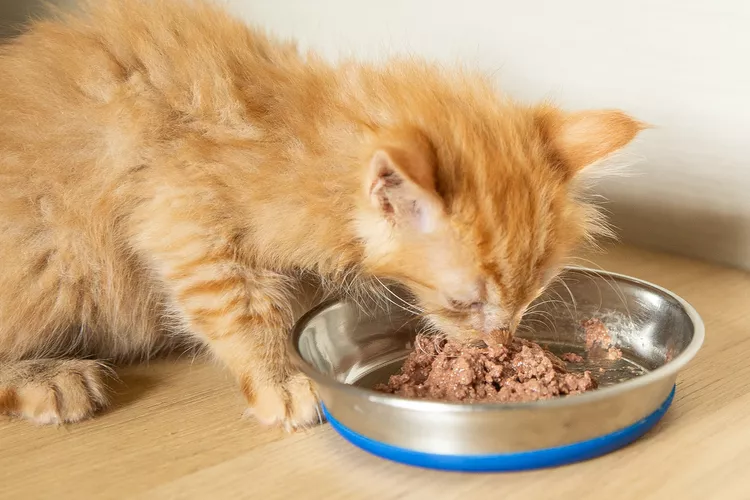Choosing the Best Food for Kittens

Congratulations on your new kitten! One of the first decisions you will need to make is to choose an appropriate diet for your kitten. Proper nutrition is one of the most important aspects of caring for your kitten. You may be feeling overwhelmed with all the cat and kitten food choices on there. Where do you begin?
Your kitten will probably have been already weaned when he first arrives at your house. If he is eating high-quality kitten food and doing well, it might be best to continue him on that food. A sudden diet change can lead to gastrointestinal upset and may also create stress while he adjusts to his new environment. However, if your kitten has been eating a lesser-quality food, you will need to gradually convert him over to more appropriate kitten food.
Kitten Food Versus Adult Cat Food
When searching for the right kitten food, it is essential that you choose a diet that will meet the needs of your growing cat. For a kitten's appropriate growth and development, he needs extra protein, fat, vitamins and minerals to get the right start in life. The extra protein is needed for growth and development of strong muscles and supporting tissue; fat is essential for fatty acids, as a carrier for fat-soluble vitamins, and for the additional calories for energy. Minerals, of course, are needed for the development of strong teeth and bones.
While adult cat food will not harm your kitten in the short term, it is selling him short on the extra nutrients he needs for active growth, which takes place throughout the first year of his life. Look for cat food that has an AAFCO label stating that it is complete and balanced for growth. Some adult cat foods are actually suitable for kittens. This is why it's important to read the label.
How to Choose the Best Kitten Food
As you begin your search from among the best kitten foods, you will need to decide if you want to feed wet food, dry kibble, or both.
The gold standard is to feed a wet food that is low in carbohydrates and high in protein. Cats are obligate carnivores, meaning they need animal protein to survive and thrive. They have no need for plant-based foods. Cats also need the moisture in their diets to keep them well-hydrated. Excess carbohydrates and too little moisture can lead to a variety of health issues later in your cat's life. Starting your kitten off with the optimal diet is the best way to get ahead of the issues. Simply put, wet food is better for your cat's health and longevity. While less convenient and often more expensive than dry food, you will find it is worth it in the long run. In fact, many vets now prefer cats to be on a more affordably-priced canned cat food than one of the higher-priced, "premium" dry foods found in pet boutiques.
Some owners prefer dry kitten food because the convenience; a large bag can be purchased and stored for several weeks, making it easier and more economical than other food options. If you go this route, choosing a high-quality dry food is essential. Many dry foods are of poor quality, so you will need to do additional homework to find nutritious options. Choose the highest protein diet possible. Any dry food automatically has too many carbohydrates for cats, so it's best to supplement with some kind of wet food.
Some owners like dry food because it is easy to leave food out for your cat all the time. This "free feeding" method is not recommended for adult cats. Free feeding not necessarily a problem for young kittens, but it should be phased out before your kitten reaches about five or six months of age. In adult cats, free feeding often leads to overeating and weight gain as kittens reach adulthood. Plus, it is more difficult to monitor your cat's intake if you just keep the bowl full all the time.
If you choose to feed dry kibble, measure out the amount recommended for your kitten's age and weight. Feed two to three times a day. The best method is to use interactive feeders or food puzzles to make your cat "work" for his food. A food-dispensing system like Doc and Phoebe's Indoor Hunting Feeder actually mimics a cat's natural hunting instincts and can prevent a variety of behavior issues down the road.
How to Change Your Kitten's Diet
Bringing a kitten home is an exciting time, but you need to take into account your pet's future health and nutritional needs. By transitioning him to a high-quality diet now, you can improve his chances for a long and happy life.
Start by adding a small amount of the new kitten food to his existing food, then gradually increase the amount each day. Increase the ratio of new to old food each day over the course of about 5 to 10 days. This slow transition can help prevent stomach ailments due to diet change. Slow down the transition if your kitten develops soft stool. If you notice diarrhea, vomiting, or loss of appetite, bring your kitten to the vet. This may or may not be from the new diet.
You may find that once your kitten tastes the higher quality food, he will nose through the kibble to find those morsels. At that point, you can make the switch to the higher quality food for the entirety of his diet.